An Excerpt from Deadlift Dynamite
If you know your way around the kettlebell, you have an unfair advantage when it comes to learning barbell skills.
Start with a barbell half-deadlift because it is less demanding of skill and flexibility. And it really teaches you to drive the hips forward, an essential element of Andy’s competition deadlift technique.
Set a bar inside a power rack just below your kneecaps and load it up with a pair of plates. Most ladies should start with “dimes” and quickly progress to “quarters;” most gents with 45s.
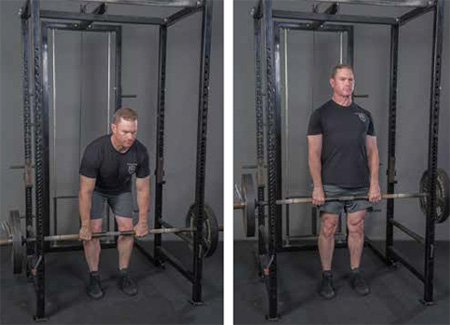
If you have wooden blocks on which to park the bar, that is even better. The pull will feel more natural, your body will not be jarred, and the bar will hold up longer.
Stand flush next to the bar, your feet narrower than shoulder width apart, your toes pointing forward or slightly out.
Through pursed lips, take a breath into your belly. Stop before you start filling your chest.
Bob Peoples, one of the first deadlift immortals, noticed that breathing into the chest made his back longer and his pull harder. He realized that breathing into his belly was the ticket.
Grip the ground with your toes and sit back, reaching for the bar with “long” arms, the triceps tensed. If you have been practicing your hip hinge stretch, your shins will be comfortably vertical and your lower back will remain straight.
For now, take a hold of the bar with a double overhand grip.
The perfect grip width demands that the arms are parallel to each other.
Crush the bar with your hands. Jim Smith comments, “Locking your grip down on the bar is the FIRST step in setting the tension in your upper body and linking it to the tension created through your lower body from anchoring it into the ground, thus creating full body tension or irradiation. More tension equals more strength and less potential for injury.”
“But another coach told me to relax my grip!”
Andy Bolton crushes the bar. Ed Coan tries to keep his grip loose. Both are deadlift superstars. Both techniques are right in the context of their training systems. Pick one leader to follow.
Here is how we do it at StrongFirst, in the words of Dr. Michael Hartle, StrongFirst Certified Master Instructor, USAPL National Champion and IPF Team USA Head Coach:
I crush the bar for squats, bench presses, and deadlifts. I was taught a long time ago to do that.
When squatting, it helps me stabilize my upper back and makes me feel locked with the bar, which makes the weight feel lighter.
In the bench press, it helps immensely. When getting a lift-off for heavy reps, it significantly reduces the “amount” of weight in the hands. Psychologically, it also helps as I feel that I have better control with the weight overhead.
In the deadlift, it helps with thoracic spine and upper back stabilization, and the weight feels lighter coming off the ground. As you know, grip is directly related to rotator cuff activation.
“Break” the bar to activate your lats.
Hiss a little to get a better abdominal contraction.
Squeeze your glutes, drive your pelvis forward, and straighten up. Crisply, with a grunt. Your shins should not move at all—visualize your shins stuck in cement.
Pause for a second at the lockout. Make sure your shoulders stay down and relaxed.
Take in air and hinge back in a controlled manner. Eventually, you’ll be doing this briskly. Slow deadlift negatives with a heavy weight are not a good idea, but you are nowhere near heavy yet.
Gently park the barbell.
Using your lats, keep the bar close to your legs through the set. This will improve your leverage and enable you to lift more weight safely.
Do several sets of five.
At this stage in the game, you need a lot of practice. Hence, you will deadlift three times a week, and will alternate barbell and kettlebell pulls: Monday—barbell, Wednesday—kettlebell, Friday—barbell, Monday—kettlebell, etc.
On the kettlebell days, do five sets of ten reps touch-and-go, sumo-style, using one or two kettlebells. The weight should be light, but not baby light, probably a third to a half of your bodyweight. These “deads” will be easy, and that is the point. You are just greasing the groove.
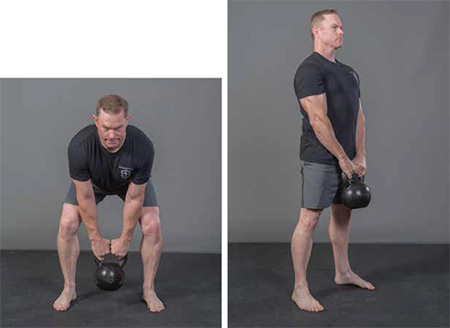
On the barbell days, do dead-stop partial barbell pulls for five sets of five reps (5 x 5). Progressively build up to bodyweight or slightly heavier. Although you can probably handle a lot more weight from your knees, do not do it. Heavy lockouts are the domain of experienced lifters.
Instead of adding weight, progressively increase the distance of the pull by setting the bar on lower power rack pins. Ideally, progress in one-inch or even half-inch increments. Since most power cages have holes spaced much farther apart than that, figure out how to make smaller jumps by standing on sheets of plywood, dense rubber, or on a 45-pound plate.
Your short-term goal is 5 x 5 with your bodyweight. Do not drop to a lower level on the pins until you can comfortably handle the weight at the previous one. Start using chalk when grip becomes an issue.
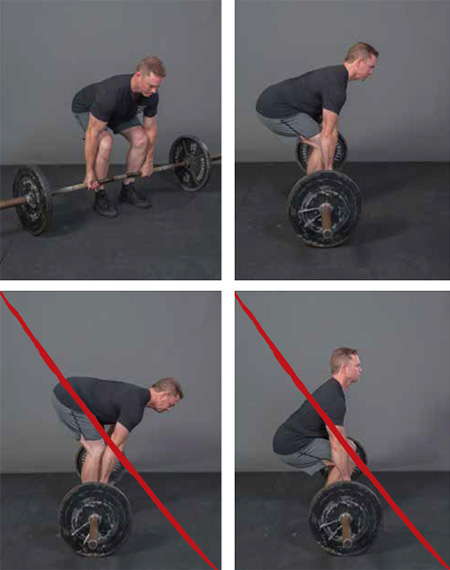
Stay with the double overhand grip until you can pull a barbell equal to your bodyweight off the platform for 5 x 5. Being challenged in this manner will not only strengthen your grip but will also teach you to pull the bar smoothly. Jerk, and it will roll out of your hands.
But the time will come when you can no longer hold on to the bar. Enter the mixed grip.
Grip the bar with one palm facing forward, and the other back. If you have ever practiced martial arts or taken a self-defense class, you know that one thumb is weaker than four fingers. This is why you were taught to push against the assailant’s thumbs to break his grip around your wrists. If you use a normal overhand grip on the bar, a heavy weight will eventually make the weaker thumbs give out. A mixed grip backs up your thumbs with the stronger fingers of your other hand. This maneuver will initially feel unnatural, but you will get used to it.
Experiment with the exact position of your hands on the bar to symmetrically load your spine. Note that placing the hands on the bar symmetrically will not do it; due to quirks in elbow anatomy, the hand with the palm facing forward needs to be farther out. Aligning the ring fingers symmetrically usually hits the sweet spot.
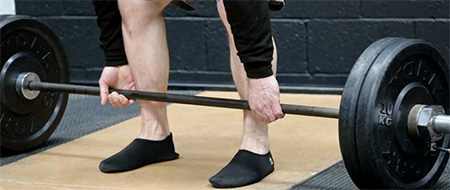
The mixed grip is not without problems. First, it creates a torque on the spine, which is why you should switch hands from set to set. One direction will feel stronger. Fine; always use it for your heavy sets. But grip the other way on many easier and warm-up sets.
Second, supinating your wrist, turning your palm forward makes the biceps vulnerable to an injury. It is absolutely imperative that you do not jerk on the bar! And keep your elbows straight! Tense your triceps and think “long arms.”
The double overhand hook grip from weightlifting is an alternative to the mixed grip. It does not have the problems of the alternate grip, but it has its own: The hook grip is rough on the thumbs. One of the authors saw Brad Gillingham sporting impressive bruises under his thumbnails a few days after he pulled close to 900 at the IPF Worlds. That said, you can get used to the pain. However, you will not be able to do reps without beating your thumbs to pulp.
If you choose to pursue this Olympic weightlifting grip, use it only in warm-ups and for singles and doubles. You will need straps for your sets of five—and additional grip work, such as Andy’s double overhand grip shrugs.
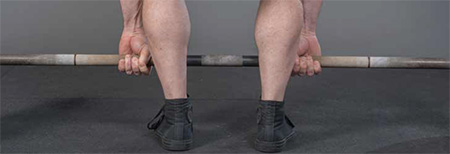
Now you got the most basic barbell deadlift technique covered. The next step is putting more reps under your belt.
Then discover professional subtleties on the pages of Deadlift Dynamite, pursue the perfection of skill, and add pounds to the bar.
Deadlift dynamite power to you!
# # #
Andy Bolton is the lifter who broke the mythical 1,000-pound deadlift barrier.
Pavel Tsatsouline is the founder of StrongFirst.
Deadlift Dynamite: How to Master the King of All Strength Exercises is available in paperback, Kindle, and PDF formats. Get your copy HERE.
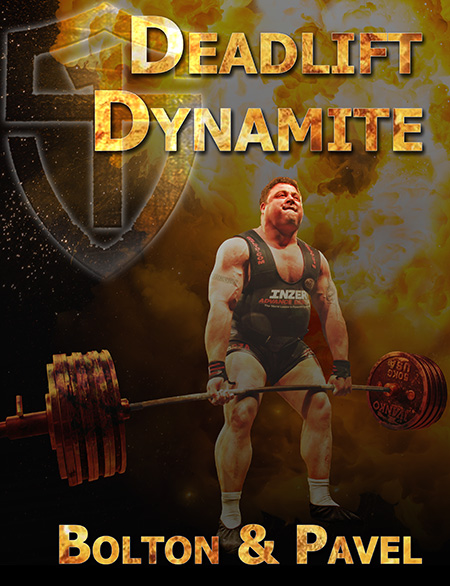
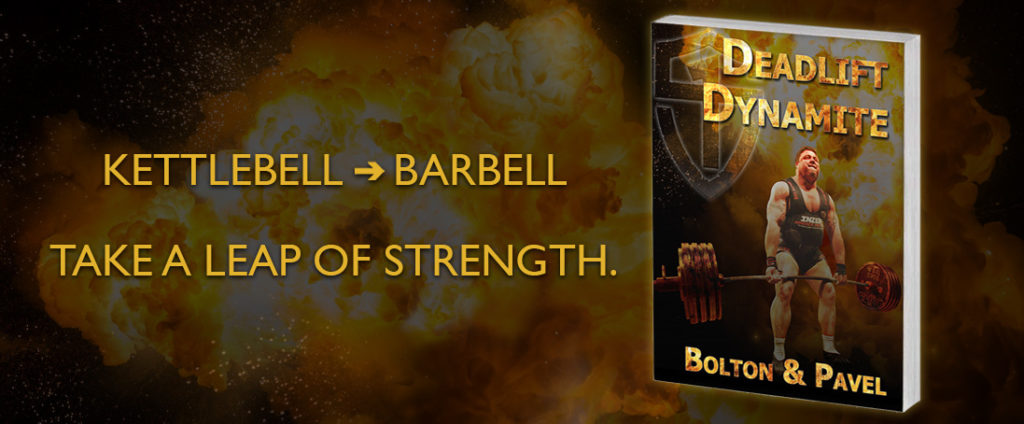
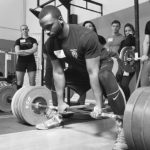

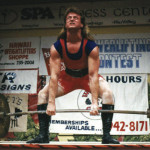
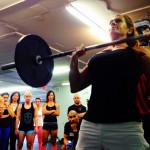


Is the book any different from the old book “Deadlift Dynamite”?
From this thread on our forum about Deadlift Dynamite: https://www.strongfirst.com/community/threads/deadlift-dynamite-program.21633/post-415543
“I have just compared the published excerpt with the same paragraphs in the old version, and I must say that Laree Draper did some great editing. The instructions are more clear and a bit more streamlined, without changing the content or character of the instructions.”
Scroll up one post and you’ll find this from me: “The book has a great new edit by Laree Draper, new photos, and an awesome design by Rachel Darvas. The content is fundamentally the same; the authors were happy with it and did not see the need to revise.”
Thanks